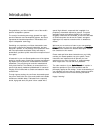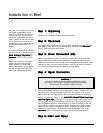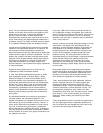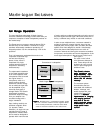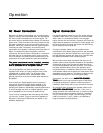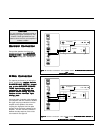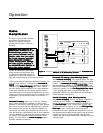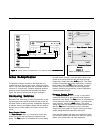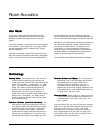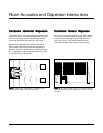
Page 7
Quest User's Manual
arrays. The test instrument needed an extremely accurate
speaker, but Janszen found that the cone speakers of the
period were too nonlinear in phase and amplitude re-
sponse to meet his criteria. Janszen believed that
electrostats were inherently more linear than cones, so he
built a model using a thin plastic diaphragm treated with a
conductive coating. This model confirmed Janszen's beliefs,
for it exhibited remarkable phase and amplitude linearity.
Janszen was so excited with the results that he continued
research on the electrostatic speaker on his own time. He
soon thought of insulating the stators to prevent the
destructive effects of arcing. By 1952 he had an electrostatic
tweeter element ready for commercial production. This new
tweeter soon created a sensation among American audio
hobbyists. Since Janszen's tweeter element was limited to
high frequency reproduction, it often found itself used in
conjunction with woofers, most notably, woofers from
Acoustic Research. These systems were highly regarded by
all audio enthusiasts.
As good as these systems were, they would soon be
surpassed by another electrostatic speaker.
In 1955, Peter Walker published three articles on electro-
static loudspeaker design in
Wireless World
, a British
electronics magazine. In these articles Walker demon-
strated the benefits of the electrostatic loudspeaker. He
explained that electrostatics permit the use of diaphragms
that are low in mass, large in area, and uniformly driven
over their surfaces by electrostatic forces. Due to these
characteristics, electrostats have the inherent ability to
produce a wide bandwidth, flat frequency response with
distortion products being no greater than the electronics
driving them.
By 1956 Walker backed up his articles by introducing a
consumer product, the now famous Quad ESL. This
speaker immediately set a standard of performance for the
audio industry due to its incredible accuracy. However, in
actual use the Quad had a few problems. It could not play
very loud, it had poor bass performance, it presented a
difficult load that some amplifiers did not like, its dispersion
was very directional, and its power handling was limited to
around 70 watts. As a result, many people continued to use
box speakers with cones.
In the early 1960's Arthur Janszen joined forces with the
KLH loudspeaker company and together they introduced
the KLH 9. Due to the large size of the KLH 9, it did not have
as many limitations as the Quad. The KLH 9 could play
markedly louder and lower in frequency than the Quad ESL.
Thus a rivalry was born.
Janszen continued to develop electrostatic designs. He was
instrumental in the design of the Koss Model One, the
Acoustech, and the Dennesen speakers. Roger West, the
chief designer of the JansZen Corporation became the
president of Sound Lab. When JansZen Corporation was
sold, the RTR loudspeaker company bought half of the
production tooling. This tooling was used to make the
electrostatic panels for the Servostatic, a hybrid electrostatic
system that was Infinity's first speaker product. Other
companies soon followed; each with their own unique
applications of the technology. These include Acoustat,
Audiostatic, Beverage, Dayton Wright, Sound Lab, and Stax
to name a few.
Electrostatic speakers have progressed and prospered
because they actually do what Peter Walker claimed they
would. The limitations and problems experienced in the
past were not inherent to the electrostatic concept. They
were related to the applications of these concepts.
Today, these limitations have been addressed. Advance-
ments in materials due to the U.S. space program give
designers the ability to harness the superiority of the
electrostatic principle. Today's electrostats use advanced
insulation techniques or provide protection circuitry. The
poor dispersion properties of early models have been
addressed by using delay lines, acoustical lenses, multiple
panel arrays or, as in our own products, by curving the
diaphragm. Power handling and sensitivity have been
increased.
These developments allow the consumer the opportunity to
own the highest performance loudspeaker products ever
built. It's too bad Rice and Kellogg were never able to see
just how far the technology would be taken.





